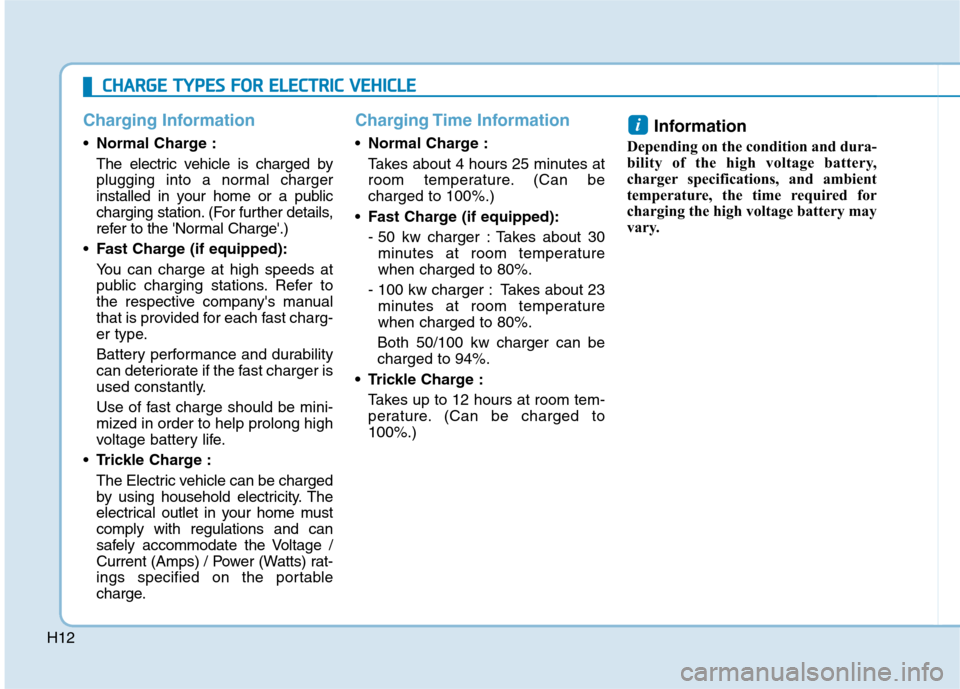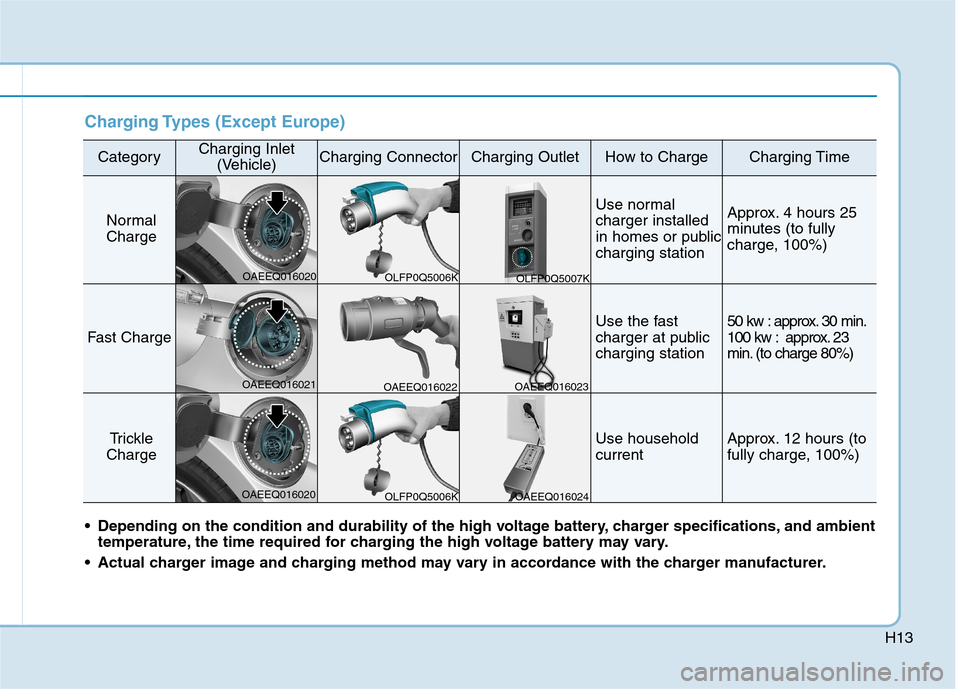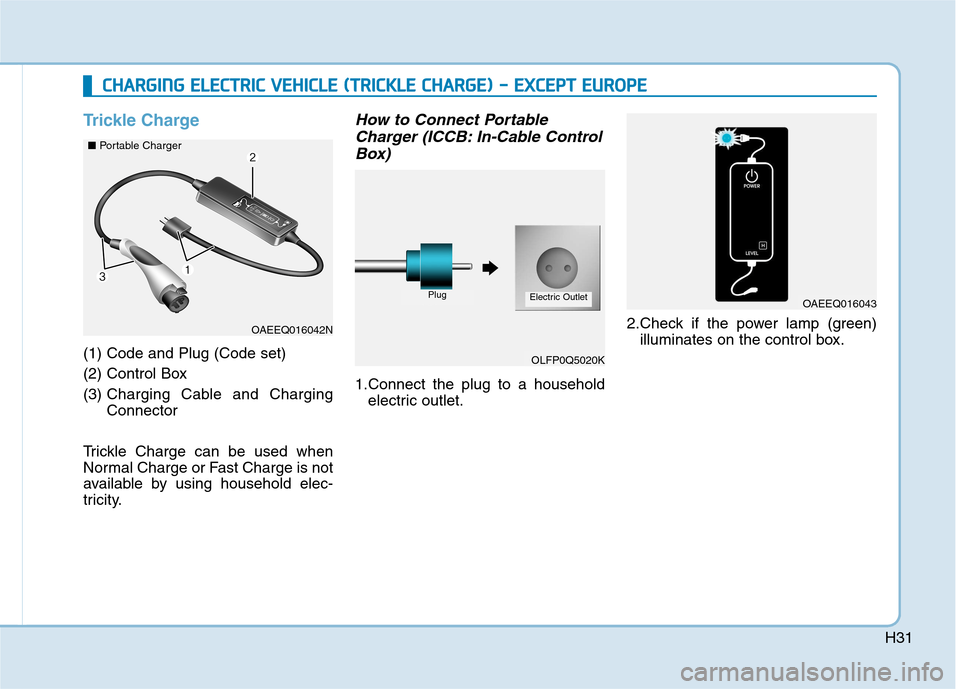2017 Hyundai Ioniq Electric trickle charging
[x] Cancel search: trickle chargingPage 8 of 582

EEllee ccttrr iicc VV eehh iicc llee SS yyssttee mm OO vvee rrvv iiee ww
Electric Vehicle ........................................................H3
Characteristics of Electric Vehicles ......................H3
Battery Information ................................................H3
Main Components of Electric Vehicle ..................H4
High Voltage Battery (lithium-ion polymer)........H5
High Voltage Battery Warmer System .................H6
EV Mode ...................................................................H7
Range .....................................................................................H7
Nearby by stations .............................................................H8
Energy Information ............................................................H8
ECO Driving ...........................................................................H9
Charging and Climate Settings.........................................H9
EV Settings .........................................................................H10
Charging Information ............................................H12
Charging Time Information ..................................H12
Charging Types (Except Europe) ........................H13
Charging Types (For Europe) ..............................H14
Charging Status .....................................................H15
Charging Connector AUTO/ LOCK Mode ...........H16 When the Charging Connector Is Locked ...................H16
Scheduled Charging...............................................H17
Charging Precautions............................................H18
Normal Charge (Except Europe) .........................H20 How to Connect Normal Charger..................................H20
Checking Charging Status ...............................................H23
How to Disconnect Normal Charger ............................H24
Unlock Charging Connector in Emergency ................H25 Fast Charge (Except Europe) ..............................H26
How to Connect Fast Charger .......................................H26
Unlock Charging Door in Emergency ..........................H28
Checking Charging Status ...............................................H29
How to Disconnect Fast Charger ..................................H30
Trickle Charge (Except Europe) ..........................H31 How to Connect Portable Charger
(ICCB: In-Cable Control Box) ..........................................H31Checking Charging Status ...............................................H35
Charging Status Indicator Lamp for
Portable Charger ...............................................................H36
How to Disconnect Portable Charger
(ICCB: In-Cable Control Box) ..........................................H39 Unlock Charging Connector in Emergency ................H40
Precautions for Portable Charger
(ICCB: In-Cable Control Box) ..........................................H40
Normal Charge (For Europe) ...............................H41 How to Connect Normal Charger..................................H41
Unlock Charging Door in Emergency ..........................H44
Checking Charging Status ...............................................H45
How to Disconnect Normal Charger ............................H46
Unlock Charging Connector in Emergency ................H47
Fast Charge (For Europe) ....................................H48 How to Connect Fast Charger .......................................H48
Unlock Charging Door in Emergency ..........................H50
Checking Charging Status ...............................................H50
How to Disconnect Fast Charger ..................................H51
Page 9 of 582

Trickle Charge (For Europe) ................................H52How to Connect Portable Charger
(ICCB: In-Cable Control Box) ..........................................H52Unlock Charging Door in Emergency ..........................H56
Checking Charging Status ...............................................H56
Charging Status Indicator Lamp for
Portable Charger ...............................................................H58
How to Disconnect Portable Charger
(ICCB: In-Cable Control Box) ..........................................H61 Unlock Charging Connector in Emergency ................H62
Precautions for Portable Charger
(ICCB: In-Cable Control Box) ..........................................H62
How to Start the Vehicle ......................................H63
How to Stop the Vehicle.......................................H64
Virtual Engine Sound System ..............................H64
Distance to Empty .................................................H65 When destination is not set ...........................................H65
When destination is set...................................................H66
Tips for Improving Distance to Empty ...............H66
ECO Guide ...............................................................H67
State of charge (SOC) gauge for high voltage
battery.....................................................................H67
Warning and Indicator Lights
(related to electric vehicle) .................................H68 Ready Indicator ................................................................H68
Service Warning Light .....................................................H68
This warning light illuminates : ......................................H68
Power Down Warning Light ...........................................H69
Charging Indicator Light..................................................H69
High Voltage Battery Level Warning Light .................H69
Regenerative Brake Warning Light ..............................H70 LCD Display Messages ..........................................H70
Shift to P to charge .........................................................H70
Remaining time ..................................................................H70
Charging Door Open ........................................................H71
Charger Error! / Quick Charger Error!........................H71
Stop vehicle and check brakes .....................................H71
Check brakes......................................................................H72
Low Battery........................................................................H72
Charge immediately. Power limited ..............................H72
Low Battery. Charge immediately.................................H73
Low Battery Temp. Power limited.................................H73
Battery Overheated! Stop vehicle ................................H73
Power limited .....................................................................H74
Stop vehicle and check power supply .........................H74
Check Active Air Flap System........................................H75
Check Virtual Engine Sound System............................H75
Check electric vehicle system .......................................H75
Energy flow ...........................................................H76 Vehicle Stop........................................................................H76
EV Propulsion ....................................................................H76
Regeneration ......................................................................H77
Aux. Battery Saver+ .............................................H77 Mode ....................................................................................H77
System Setting...................................................................H78
LCD Message .....................................................................H78
If an Accident Occurs ...........................................H79
Other Precautions for Electric Vehicle ..............H81
Service Plug ...........................................................H81
Page 19 of 582

H12
Charging Information
Normal Charge :
The electric vehicle is charged by
plugging into a normal charger
installed in your home or a public
charging station. (For further details,
refer to the 'Normal Charge'.)
Fast Charge (if equipped):
You can charge at high speeds at
public charging stations. Refer to
the respective company's manual
that is provided for each fast charg-
er type.
Battery performance and durability
can deteriorate if the fast charger is
used constantly.
Use of fast charge should be mini-
mized in order to help prolong high
voltage battery life.
Trickle Charge :
The Electric vehicle can be charged
by using household electricity. The
electrical outlet in your home mustcomply with regulations and can
safely accommodate the Voltage /
Current (Amps) / Power (Watts) rat-
ings specified on the portable
charge.
Charging Time Information
Normal Charge :
Takes about 4 hours 25 minutes at
room temperature. (Can becharged to 100%.)
Fast Charge (if equipped):
- 50 kw charger : Takes about 30
minutes at room temperature when charged to 80%.
- 100 kw charger : Takes about 23 minutes at room temperaturewhen charged to 80%.
Both 50/100 kw charger can becharged to 94%.
Trickle Charge :
Takes up to 12 hours at room tem-
perature. (Can be charged to100%.) Information
Depending on the condition and dura-
bility of the high voltage battery,
charger specifications, and ambient
temperature, the time required for
charging the high voltage battery may
vary.
i
CC HH AARRGG EE TT YY PPEESS FF OO RR EE LLEE CCTT RR IICC VV EEHH IICC LLEE
Page 20 of 582

H13
Charging Types (Except Europe)
CategoryCharging Inlet(Vehicle)Charging ConnectorCharging OutletHow to ChargeCharging Time
Normal
Charge
Use normal charger installed
in homes or publiccharging stationApprox. 4 hours 25
minutes (to fully
charge, 100%)
Fast Charge
Use the fast
charger at publiccharging station50 kw : approx. 30 min.
100 kw : approx. 23
min. (to charge 80%)
Trickle
Charge Use household currentApprox. 12 hours (to
fully charge, 100%)
Depending on the condition and durability of the high voltage battery, charger specifications, and ambient temperature, the time required for charging the high voltage battery may vary.
Actual charger image and charging method may vary in accordance with the charger manufacturer. OLFP0Q5006K
OAEEQ016020
OAEEQ016021
OAEEQ016020 OAEEQ016022
OAEEQ016023
OAEEQ016024 OLFP0Q5007K
OLFP0Q5006K
Page 21 of 582

H14
Charging Types (For Europe)
CategoryCharging Inlet(Vehicle)Charging ConnectorCharging OutletHow to ChargeCharging Time
Normal
Charge
Use normal charger installed
in homes or publiccharging stationApprox. 4 hours 25
minutes (to fully
charge, 100%)
Fast Charge
Use the fast
charger at publiccharging station50 kw : approx. 30 min.
100 kw : approx. 23
min. (to charge 80%)
Trickle
Charge Use household currentApprox. 12 hours (to
fully charge, 100%)
Depending on the condition and durability of the high voltage battery, charger specifications, and ambient temperature, the time required for charging the high voltage battery may vary.
Actual charger image and charging method may vary in accordance with the charger manufacturer. OAEEQ016078L
OAEEQ016020L
OAEEQ016021L
OAEEQ016020L OAEEQ016022L
OAEEQ016023
OAEEQ016024 OLFP0Q5007K
OAEEQ016078L
CC HH AARRGG EE TT YY PPEESS FF OO RR EE LLEE CCTT RR IICC VV EEHH IICC LLEE (( CC OO NNTT..))
Page 24 of 582

H17
Scheduled Charging (if equipped)
You can set-up a charging sched-ule for your vehicle using the AVN or Blue Link application.
Refer to the Multimedia manual or
the Blue Link manual for detailed
information about setting sched-uled charging.
Scheduled charging can only be done when using a normal charger
or the portable charger (ICCB: In-
Cable Control Box). When scheduled charging is set
and the normal charger or the
portable charger (ICCB: In-Cable
Control Box) is connected forcharging, the indicator lamp in the
middle blinks (for 3 minutes) toindicate that scheduled charging isset.
When scheduled charging is set, charging is not initiated immediate-
ly when the normal charger or
portable charger (ICCB: In-Cable
Control Box) is connected. Whenimmediate charging is required,
use the AVN to deactivate thescheduled charge setting or press
schedule charging deactivation
( ) button. If you press the scheduled charg-
ing deactivation ( ) button to
immediately charge the battery,
charging must be initiated 3 min-
utes after the charging cable hasbeen connected.
When you press the scheduled
charging deactivation ( ) forimmediate charging, the scheduledcharge setting is not completely
deactivated. If you need to com-
pletely deactivate the scheduled
charge setting, use the AVN to
finalize the deactivation.
Refer to "Normal Charge or Trickle
Charge" for details about connecting
the normal charger and the portable
charger (ICCB: In-Cable Control Box).
OAEEQ016026
SS CC HH EEDD UU LLEE DD CC HH AARRGG IINN GG
OAEEQ016027
Page 38 of 582

H31
Trickle Charge
(1) Code and Plug (Code set)
(2) Control Box(3) Charging Cable and Charging Connector
Trickle Charge can be used when
Normal Charge or Fast Charge is not
available by using household elec-
tricity.
How to Connect Portable Charger (ICCB: In-Cable Control Box)
1.Connect the plug to a household electric outlet. 2.Check if the power lamp (green)
illuminates on the control box.
CCHH AARRGG IINN GG EE LLEE CCTT RR IICC VV EEHH IICC LLEE (( TT RR IICC KK LLEE CC HH AARRGG EE)) -- EE XX CCEE PP TT EE UU RROO PPEE
OAEEQ016042N
OLFP0Q5020K
PlugElectric OutletOAEEQ016043
■
Portable Charger
Page 59 of 582

H52
Trickle Charge
(1) Code and Plug (Code set)
(2) Control Box(3) Charging Cable and Charging Connector
Trickle Charge can be used when
Normal Charge or Fast Charge is not
available by using household elec-
tricity.
How to Connect Portable Charger (ICCB: In-Cable Control
Box)
1.Connect the plug to a household electric outlet. 2.Check if the power lamp (green)
illuminates on the control box.
CCHH AARRGG IINN GG EE LLEE CCTT RR IICC VV EEHH IICC LLEE (( TT RR IICC KK LLEE CC HH AARRGG EE)) -- FF OO RR EE UU RROO PPEE
OAEEQ016042
OLFP0Q5020K
PlugElectric OutletOAEEQ016043
■
Portable Charger